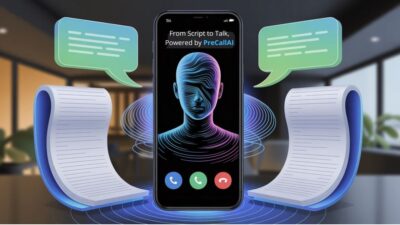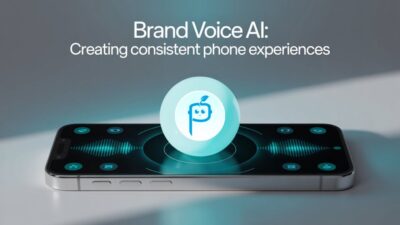Introduction
I talked to Dr. Sarah Chen. She is a dentist in town. She was frustrated. Her practice was losing $15,000 every month. there were missed opportunities. Calls were going to voicemail. Everyone was busy with patients. There were scheduling mix-ups. This happened in busy times.
Potential patients just hanging up. They got put on hold for a long time. She noticed the problem. Wanted to help her front desk. Make sure no patient was forgotten. She looked into automated appointment scheduling calls.
There came a solution. It changed everything. She started using automated appointment scheduling calls. Her booking rate went from 23% to 89% in 30 days. She is no longer trying to find patients. Now she has a two-week waiting list.
Table of Contents
This is not a lucky break. AI can handle appointment scheduling. You can miss calls while helping clients. Lose customers to competitors. You should learn about this.
The Real Problem: What Manual Scheduling Costs You For Automated Appointment Scheduling Calls
Look, I get it. Most business owners think they’re saving money by handling all their appointments themselves. It’s a completely different story.
Let me tell you about Maria, who runs a yoga studio down in Austin. She decided to track everything for a month, and the results were pretty eye-opening:
- Total calls coming in: 147
- Calls she answered: 52 (that’s only 35%)
- Calls that turned into appointments: 23 (16% of all calls)
- What she makes per appointment: $85
- Money walking out the door: $8,075 every single month
She is losing almost $97,000 a year. Not answering the phone. Use to teach in classes.
Why Your Current System Doesn’t Work Anymore
Here’s the thing about today’s customers – they want everything right now. Someone decides they need a haircut, teeth cleaning, or consultation. They want to book it right away.Not tomorrow, not after you call them back from their voicemail.
The research backs this up, too:
- 78% of people won’t even bother leaving a voicemail for appointments
- 62% will call your competitor
- 45% expect to book appointments
- 83% want immediate confirmation, not a “we’ll call you back”
Your service is that you’re not available. People need you. And that’s exactly what automated appointment scheduling calls fix.
What Are Automated Appointment Scheduling Calls?
Think of automated appointment scheduling calls as having the world’s best receptionist who never needs sleep, never takes a sick day, and never has an off day. This isn’t like those awful phone tree systems from the 90s that everyone hates. Today’s AI sounds like a real person having a real conversation.
Most customers don’t even realize they’re talking to AI – it’s that natural.
Here’s How It Works
Someone calls your business, here’s what happens:
- Instant pickup – The AI answers in 2-3 rings, every single time
- Real conversation – The customer explains what they need in plain English
- Smart scheduling – The AI checks your actual calendar and suggests times that work
- Seamless booking – Everything gets scheduled, confirmed, and added to your calendar automatically
- Follow-up – Customer gets confirmation texts and emails without you lifting a finger. it is easy to follow up calls.
- Reminders – Automated reminders cut no-shows by 70%
The whole thing takes maybe 2-3 minutes and feels exactly like talking to your best employee.
Real Example: Tom’s Auto Shop
Tom runs a small auto repair shop in Phoenix. He lost 40% of his service calls. He was always under a car hood. Here’s what a typical call sounds like now:
Customer: “Hi, I need to get my brakes checked. At what time can I bring my car in?”
AI: “I’d be happy to help you schedule a brake inspection. We have availability tomorrow at 10 AM or 2 PM, or Thursday at 9 AM. What works better for you?”
Customer: “Tomorrow at 2 PM sounds perfect.”
AI: “Great! I’ll book you for tomorrow, Tuesday, at 2 PM for a brake inspection. Can I get your name and phone number?”
[Gets the details, confirms everything, sends a confirmation text]
AI: “Perfect, Mike. You’re all set for tomorrow at 2 PM. I’ve sent you a confirmation text with our address. Is there anything else I can help you with today?”
Everyone wins – the customer gets help immediately, Tom gets a confirmed appointment, and nobody had to stop what they were doing.
5 Ways Automated Appointment Scheduling Calls Will 5X Your Bookings
1. You’re Open 24/7
Your competitors were missing calls. Your AI is booking appointments.
Jennifer runs a massage therapy practice, and after she set up 24/7 AI scheduling, her bookings went up 312%. The biggest shock? Most people wanted to book between 7-9 PM and on weekend mornings – times. She was not available.
2. No More Waiting = No More Hang-ups
The average person waits 4.2 minutes on hold for appointment scheduling. For every minute they wait, 15% more people just hang up. With automated appointment scheduling calls, there’s no waiting – ever.
Dr. Rodriguez runs a dental practice, and his call abandonment rate dropped from 35% to 3% just by having AI pick up instantly. Those crazy busy times that used to create bottlenecks? Gone. AI can handle as many calls as come in.
3. No More Double-Bookings
Manual scheduling creates conflicts, and that’s embarrassing for everyone involved. AI checks your calendar. It offers available slots.
Carlos runs a consulting firm. He was dealing with 2-3 scheduling conflicts every week without AI. That meant awkward phone calls and unhappy clients. Now? Zero conflicts in six months.
4. Smart Upselling That Works
Most businesses miss easy chances to increase booking value. Staff focus only on scheduling appointments. AI can suggest add-ons in the booking process.
Someone books a basic car wash. The AI might say, “We have a detail package with interior cleaning for $25 more. Would you like me to add that?”
Mike runs a car wash, and his average appointment value went from $35 to $58 just from AI-suggested add-ons.
5. Automated Follow-up That Cuts No-Shows
No-shows cost service businesses an average of $200 per missed appointment. Comprehensive follow-up sequences keep people engaged. It reduce no-shows dramatically.
The system works like this:
- Immediate confirmation
- 24-hour reminder with easy rescheduling
- 2-hour final reminder for same-day appointments
- Follow-up after the appointment for feedback and rebooking
Average no-show rates drop from 25% to 7% with this kind of automated follow-up.
Real Success Stories from Different Industries
Healthcare: Making Patient Appointment Scheduling Simple
Dr. Patel runs a family practice, and medical scheduling is complicated – you’ve got insurance verification, different appointment types, provider availability, all kinds of moving parts.
His AI scheduling system handles all of that:
- Verifies insurance
- Schedules are based on what type of appointment they need
- Collects necessary information
- Sends preparation instructions automatically
In 90 days, his results were pretty incredible:
- Appointment booking got 400% more efficient
- Administrative time dropped by 8 hours per week
- Patient satisfaction went from 7.2 to 9.4
- No-shows dropped from 22% to 6%
Home Services: Handling Everything from Emergencies to Routine Maintenance
Tom’s HVAC company handled emergency calls and routine maintenance. Each had different pricing and urgency.
His AI system:
- Knows the difference between emergencies and routine calls
- Quotes the right pricing for different services
- Schedules based on where technicians are and what they’re doing
- Gets equipment details
In 6 months:
- Emergency call capture went to 95% (from 23%)
- Routine maintenance bookings increased by 340%
- Call-to-booking conversion hit 78%
- Customer satisfaction averaged 9.1/10
Professional Services: Qualifying Leads
Johnson & Associates is a law firm, and they needed to make sure they weren’t wasting time on consultations with people who weren’t serious prospects.
Their AI system:
- Does initial case screening
- Qualifies prospects based on case type and budget
- Schedules with the right attorney for their situation
- Tells them what documents they need to bring
In 4 months:
- Qualified lead conversion jumped to 73% (from 31%)
- Time spent on unqualified prospects dropped 85%
- Average case value increased by $2,400
- Attorney time utilization improved 34%
Beauty and Wellness: Managing Complex Service Combinations
Serenity Spa offers tons of different services with different timing requirements, and they need specific staff and equipment for different treatments.
Their AI system:
- Understands how different services work together
- Schedules with staff who have the right expertise
- Suggests complementary services naturally
- Manages equipment availability for specialized treatments
In 8 months:
- Multi-service bookings increased by 190%
- Average appointment value went from $78 to $127
- Scheduling conflicts were eliminated
- Staff utilization improved 23%
How the Technology Works
Natural Conversation (Not Robotic Scripts)
Modern AI doesn’t rely on rigid scripts or waiting for specific keywords. It understands what people mean.
Customers can say, “I need my car inspected. The registration will expires next week.” The AI understands this is time-sensitive. It schedules the appointment. The AI can handle interruptions and answer questions. It can change its tone based on someone sounds stressed, casual, or frustrated.
Real-Time Integration with Your Existing Systems
The real power comes from connecting with everything you already use:
Calendar systems like Google Calendar, Outlook, Calendly – checking availability in real-time, creating appointments automatically, and preventing conflicts
CRM systems like Salesforce, HubSpot – creating leads. It access customer history in calls. It trigger follow-up sequences
Payment processing through Stripe, Square, PayPal. It collects deposits in booking, sending payment reminders, handling refunds for cancellations
Communication tools – SMS confirmations, email follow-ups, WhatsApp for younger customers, voice messages for complex instructions
Machine Learning That Gets Better Over Time
AI appointment scheduling learns. It improves:
- Response timing based on what converts best
- Language patterns that increase booking rates
- Upselling opportunities that customers want
- Scheduling preferences by customer type
- Seasonal demand patterns
Every week, the system analyzes performance and makes adjustments. It A/B tests different approaches, optimizes integrations, and refines industry-specific customizations.
Cost Comparison: AI vs. Traditional Scheduling
Traditional Scheduling Costs (Per Year)
Full-time receptionist:
- Salary: $35,000
- Benefits: $10,500
- Training: $3,000
- Coverage for sick days/vacation: $4,500
- Total: $53,000
Part-time scheduling support:
- 25 hours/week at $18/hour: $23,400
- Payroll taxes: $1,800
- Training: $1,500
- Lost revenue from coverage gaps: $6,000
- Total: $32,700
Automated Appointment Scheduling Calls Cost (Per Year)
AI scheduling system:
- Monthly subscription: $297
- Setup and customization: $1,500 (one-time)
- Integration support: $500 (one-time)
- Total Year 1: $5,564
- Total Year 2+: $3,564
Cost savings: $47,436 annually
ROI Example: Small Dental Practice
Current situation:
- Average appointment value: $150
- Booking rate: 35% of calls
- Monthly calls: 180
- Monthly bookings: 63
- Monthly revenue: $9,450
With automated appointment scheduling calls:
- New booking rate: 78% of calls
- New monthly bookings: 140
- New monthly revenue: $21,000
- Revenue increase: $11,550/month
- Annual revenue increase: $138,600
Investment: $5,564 (Year 1) ROI: 2,390% in Year 1
Common Concerns (And Why They’re Not Problems)
“My Customers Won’t Want to Talk to AI”
This is the biggest concern I hear. 73% of customers can’t tell they are talking to AI after 30 seconds. Customers care about getting their appointment booked quickly and correctly. They do not mind. A human or AI helps them.
The numbers prove it:
- Customer satisfaction with AI scheduling: 8.7/10 average
- Human receptionist satisfaction: 7.2/10 average
- Call completion rates: 94% for AI vs. 89% for humans
“My Business is Too Complicated for AI”
I hear this a lot. Modern AI handles complexity. I’ve seen it successfully manage:
- Multi-service appointments with different staff requirements
- Insurance verification and coverage explanations
- Equipment scheduling and resource allocation
- Multi-location booking with staff coordination
- Group appointments and family scheduling
Rodriguez Construction uses AI to schedule site visits with specific trade expertise, coordinate material deliveries, set up permit inspections, manage multi-phase projects, and coordinate subcontractors across multiple projects. The AI accesses their project management system, staff calendars, and resource availability to provide accurate scheduling in real-time.
“What Mistakes AI Makes?”
AI makes fewer mistakes. It learns from every interaction. Here’s what prevents errors:
- Confidence scoring for every decision
- Automatic escalation
- Human override capability anytime
- Detailed logging for quality assurance
- Continuous learning from corrections
The performance comparison:
- AI scheduling accuracy: 96.3% average
- Human scheduling accuracy: 91.7% average
- AI consistency: Identical performance every time
- Human consistency: Varies by person, mood, and experience
“I Need Personal Relationships with My Customers”
This is a great point. AI scheduling frees up your time. Use AI for routine bookings. Use the saved time to provide great service in appointments.
Dr. Martinez found that patients liked quick, efficient booking. They valued personal attention in more appointments. Patient retention increased. He had more time to spend with each patient. He was no longer interrupted by scheduling calls.
Getting Started: Your Implementation Guide
Phase 1: Assessment and Planning (Week 1)
Figure out your current situation:
- Track call volume and patterns for one week
- Identify them
- Document your current booking process and pain points
- Calculate conversion rates and lost revenue
- Ask customers what they want in scheduling
Set your goals:
- Define specific targets (booking rate, response time, etc.)
- Establish success metrics and how you’ll track them
- Set realistic timeline expectations
- Identify what systems need to integrate
Phase 2: System Setup and Customization (Week 2-3)
Configure the AI:
- Choose voice personality that matches your brand
- Create conversation flows for your services
- Set up calendar and CRM connections
- Configure pricing and availability rules
- Test different booking scenarios with your team
Train your staff:
- How to work with AI scheduling
- Time to handle escalated calls
- Using AI-generated appointment data
- Monitoring system performance and customer feedback
Phase 3: Soft Launch (Week 4)
Limited deployment:
- Start with specific hours (like after-hours only)
- Monitor every interaction closely
- Gather customer feedback through surveys
- Make adjustments based on what you learn
- Document lessons learned
Phase 4: Full Implementation (Week 5+)
Complete deployment:
- 24/7 AI appointment scheduling
- Full integration with all business systems
- Comprehensive performance monitoring
- Regular optimization based on data
- Expansion to additional features
Advanced Strategies for Maximum Results
Multi-Channel Booking Experience
Don’t limit AI to just phone calls. Extend it across all customer touchpoints:
- Phone calls handled by an AI agent
- Website chat using the same intelligence
- SMS booking for quick appointments
- Email scheduling for complex requests
- Social media message integration
This gives customers a consistent experience and choice, leading to higher conversion rates.
Proactive Outreach and Predictive Scheduling
Use AI to anticipate customer needs:
- Dental cleaning reminders based on previous appointments
- Seasonal service notifications (HVAC, lawn care)
- Subscription renewal scheduling
- Follow-up appointments after consultations
- Birthday or anniversary service offers
Lisa’s hair salon uses AI to call clients 6 weeks. This increased rebooking rates from 42% to 78%.
Dynamic Pricing and Revenue Optimization
Train your AI to optimize revenue:
- Peak-time pricing for high-demand slots
- Discounts to fill cancellations
- Package deals for multiple services
- Seasonal promotion deployment
- A/B testing different pricing strategies
Business Intelligence Through Booking Data
Use scheduling data for insights:
- Peak demand identification for capacity planning
- Service popularity trends
- Customer behavior patterns
- Price sensitivity analysis
- Seasonal demand forecasting
Measuring Success: KPIs That Matter
Primary Performance Metrics
Booking performance:
- Call-to-appointment conversion rate (target: 75 %+)
- Average booking value per call
- Time from contact to confirmed appointment
- Appointment confirmation rate
- Show-up rate (scheduled vs. actual)
Customer experience:
- Customer satisfaction scores
- Net Promoter Score (NPS)
- Call completion rate
- Average call duration
- Customer effort score
Business impact:
- Monthly recurring revenue from new bookings
- Customer lifetime value improvement
- Staff productivity gains
- Operational cost reduction
- Market share growth
Advanced Analytics
Customer behavior insights:
- Preferred booking times and days
- Service combination patterns
- Seasonal demand fluctuations
- Customer journey mapping
- Retention and rebooking rates
Operational efficiency:
- Staff utilization optimization
- Resource allocation improvements
- No-show rate reduction
- Cancellation pattern analysis
- Revenue per available hour
What’s Coming Next in Automated Appointment Scheduling Calls
Emerging Capabilities (2025-2026)
AI-powered enhancements:
- Video consultation scheduling with automatic link generation
- Emotion recognition for personalized approaches
- Multi-language switching within conversations
- Integration with wearable devices for health-based scheduling
- Predictive maintenance scheduling
Business process integration:
- Automatic staff scheduling based on bookings
- Inventory management for service preparation
- Customer journey automation beyond booking
- Real-time capacity optimization across locations
Long-Term Evolution (2026-2028)
Advanced personalization:
- Customer preference learning
- Personalized service recommendations
- Dynamic pricing based on individual customer value
- Predictive rebooking
Industry-specific innovations:
- Medical scheduling with symptom-based triage
- Legal consultation scheduling with case complexity assessment
- Home service scheduling with emergency priority algorithms
- Beauty service scheduling with skin analysis integration
Is Automated Appointment Scheduling Calls Right for You?
You’re a perfect candidate:
- You get 20 more appointment requests per week
- You miss calls with current customers
- You lose bookings to competitors with better availability
- Your current scheduling takes 5 more minutes per appointment
- You want 24/7 booking availability
- You’re tired of phone tag with potential customers
- You want to reduce no-shows and increase satisfaction
You might want to wait:
- You get 10 fewer appointment requests per month
- Your booking rate is already above 90%
- You have plenty of staff for phone coverage
- Your customers need complex, consultative booking conversations
- You’re planning major business changes in the next 6 months
ROI Calculation for Your Business
Simple formula:
- Monthly appointment requests × Current booking rate = Current bookings
- Monthly appointment requests × 75% (AI booking rate) = Potential bookings
- (Potential bookings – Current bookings) × Average appointment value = Monthly revenue increase
- Monthly revenue increase – AI system cost = Net monthly benefit
Example for a small business:
- Monthly requests: 80
- Current booking rate: 40%
- Current bookings: 32
- AI potential bookings: 60
- Additional bookings: 28
- Average appointment value: $120
- Monthly revenue increase: $3,360
- AI system cost: $300
- Net monthly benefit: $3,060
Taking Action: Your Next Steps
The appointment scheduling game has completely changed. Businesses using automated appointment scheduling calls are taking market share from competitors. Here’s what to do right now:
- Audit your current performance – Track your booking rate, missed calls, and customer feedback for one week
- Calculate your opportunity – Use the ROI formula to see your potential gains
- Research AI solutions – Compare features, pricing, and integration capabilities
- Start with a trial – Most platforms offer risk-free trials
- Plan your implementation – Use the phased approach I outlined
The Competitive Reality
Some of your competitors are implementing automated appointment scheduling calls. They’re capturing the after-hours calls you’re missing, converting the prospects you lose to voicemail, and building a reputation for exceptional availability.
The Window of Opportunity
Early adopters get the biggest advantage. As AI scheduling becomes standard, the competitive edge shrinks. The businesses implementing these systems are capturing market share. It will be hard to win back.
Read This: Advance Voice AI Can Beat iOS 26 New Feature
Conclusion

Automated appointment scheduling calls aren’t just about answering phones – they’re about transforming your entire customer acquisition process. AI scheduling becomes your most effective sales tool. Working around the clock to capture opportunities, qualify prospects. It grow your business.
The results speak for themselves:
- 95%+ call answer rates
- 75 %+ booking conversion rates
- 70% reduction in no-shows
- 2,400 %+ average ROI
Beyond the numbers, automated appointment scheduling calls give you peace of mind.
Ready to 5X your booking rate? The time to act is now. Your competitors are already using automated appointment scheduling calls to capture the appointments you’re missing. The real question is you’ll be one of the first to benefit from it. You end up trying to catch up.
Do not allow potential customer slip away to voicemail. Start your transformation today and see how automated appointment scheduling calls can revolutionize your business.






[…] Read More: How Automated Appointment Scheduling Calls Can 5X Your Booking Rate In 2025 […]